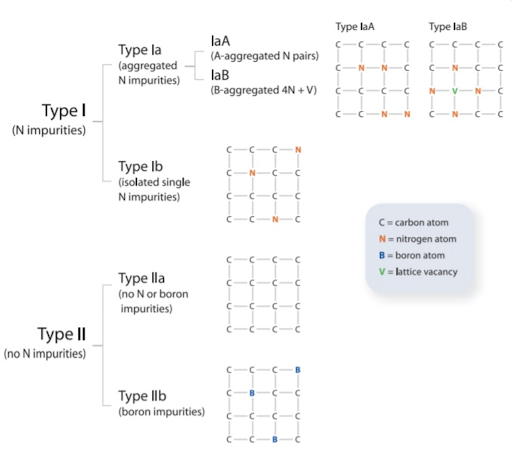Did you know that two types of diamonds are used to classify a diamond? In this blog, we will tackle the various kinds of diamonds.
The two types of diamonds, namely:
Type I. Type I contains nitrogen impurities.
Type II. Type II without nitrogen impurities contamination.
However, these two types of the diamonds can be further broken down into 5 subtypes: Type 1a, Type 1b, Type 1aB, Type 2a, and Type 2b.

Type Ia Diamonds. These types of diamonds contain bunched nitrogen atoms, and they are calculated to make up 95% of the world's raw diamonds. Type 1a diamonds can vary in various colors, from near-colorless to lightly colored. And lightly colored means having more traces of nitrogen. However, they are primarily yellowish in the shade because of the nitrogen composition.
Type Ib Diamonds. These types of diamonds are sporadic and make up less than 0.1% of natural diamonds. Similar to the I1 kind of diamonds, they also possess traces of nitrogen in their crystal lattice. The 1b type of diamonds tends to have intense hues like yellow (canary), orange or brown.
Type IIa diamonds. These types of diamonds contain practically no measurable contaminants (e.g., no nitrogen or boron) and make up roughly 1% of all-natural diamonds. Moreover, type IIa stones are chemically the purest and an apple of the eye of the investors. They are occasionally called "Golconda diamonds" and are known for their D color, no fluorescence, and high transparency ratings. While most type IIa diamonds are colorless, they can also be (e.g., yellow, pink, red, or blue).
Type IIb diamonds. These types of diamonds are the rarest and most fascinating diamond globally. Less than 0.1% of natural diamonds belong to this type, and they only contain Boron impurities, which means it has no Nitrogen in their composition. Thus, the physical elements of the diamond are altered, and they generally result in blue, gray color hues, which makes them favorably desired by collectors.

